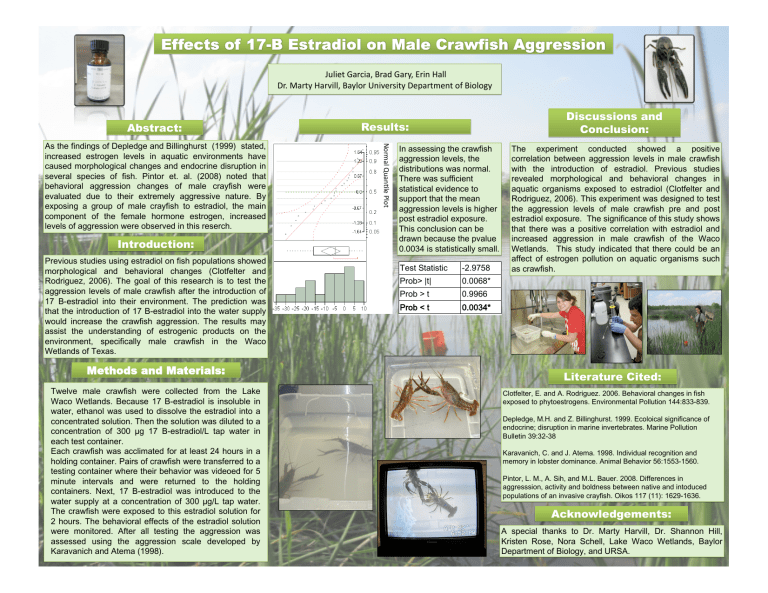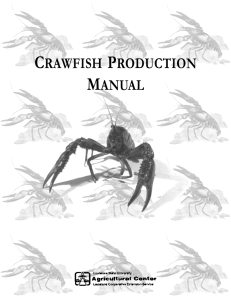Introduction: Methods and Materials: Results: Discussions and

Abstract:
As the findings of Depledge and Billinghurst (1999) stated, increased estrogen levels in aquatic environments have caused morphological changes and endocrine disruption in several species of fish. Pintor et. al. (2008) noted that behavioral aggression changes of male crayfish were evaluated due to their extremely aggressive nature. By exposing a group of male crayfish to estradiol, the main component of the female hormone estrogen, increased levels of aggression were observed in this reserch.
Introduction:
Previous studies using estradiol on fish populations showed morphological and behavioral changes (Clotfelter and
Rodriguez, 2006). The goal of this research is to test the aggression levels of male crawfish after the introduction of
17 B-estradiol into their environment. The prediction was that the introduction of 17 B-estradiol into the water supply would increase the crawfish aggression. The results may assist the understanding of estrogenic products on the environment, specifically male crawfish in the Waco
Wetlands of Texas.
Methods and Materials:
Twelve male crawfish were collected from the Lake
Waco Wetlands. Because 17 B-estradiol is insoluble in water, ethanol was used to dissolve the estradiol into a concentrated solution. Then the solution was diluted to a concentration of 300 µg 17 B-estradiol/L tap water in each test container.
Each crawfish was acclimated for at least 24 hours in a holding container. Pairs of crawfish were transferred to a testing container where their behavior was videoed for 5 minute intervals and were returned to the holding containers. Next, 17 B-estradiol was introduced to the water supply at a concentration of 300 µg/L tap water.
The crawfish were exposed to this estradiol solution for
2 hours. The behavioral effects of the estradiol solution were monitored. After all testing the aggression was assessed using the aggression scale developed by
Karavanich and Atema (1998).
Juliet Garcia, Brad Gary, Erin Hall
Dr. Marty Harvill, Baylor University Department of Biology
Results:
In assessing the crawfish aggression levels, the distributions was normal.
There was sufficient statistical evidence to support that the mean aggression levels is higher post estradiol exposure.
This conclusion can be drawn because the pvalue
0.0034 is statistically small.
Discussions and
Conclusion:
The experiment conducted showed a positive correlation between aggression levels in male crawfish with the introduction of estradiol. Previous studies revealed morphological and behavioral changes in aquatic organisms exposed to estradiol (Clotfelter and
Rodriguez, 2006). This experiment was designed to test the aggression levels of male crawfish pre and post estradiol exposure. The significance of this study shows that there was a positive correlation with estradiol and increased aggression in male crawfish of the Waco
Wetlands. This study indicated that there could be an affect of estrogen pollution on aquatic organisms such as crawfish.
Test Statistic -2.9758
Prob> |t| 0.0068*
Prob > t 0.9966
Prob < t 0.0034*
Literature Cited:
Clotfelter, E. and A. Rodriguez. 2006. Behavioral changes in fish exposed to phytoestrogens. Environmental Pollution 144:833-839.
Depledge, M.H. and Z. Billinghurst. 1999. Ecoloical significance of endocrine; disruption in marine invertebrates. Marine Pollution
Bulletin 39:32-38
Karavanich, C. and J. Atema. 1998. Individual recognition and memory in lobster dominance. Animal Behavior 56:1553-1560.
Pintor, L. M., A. Sih, and M.L. Bauer. 2008. Differences in aggresssion, activity and boldness between native and intoduced populations of an invasive crayfish. Oikos 117 (11): 1629-1636.
Acknowledgements:
A special thanks to Dr. Marty Harvill, Dr. Shannon Hill,
Kristen Rose, Nora Schell, Lake Waco Wetlands, Baylor
Department of Biology, and URSA.





